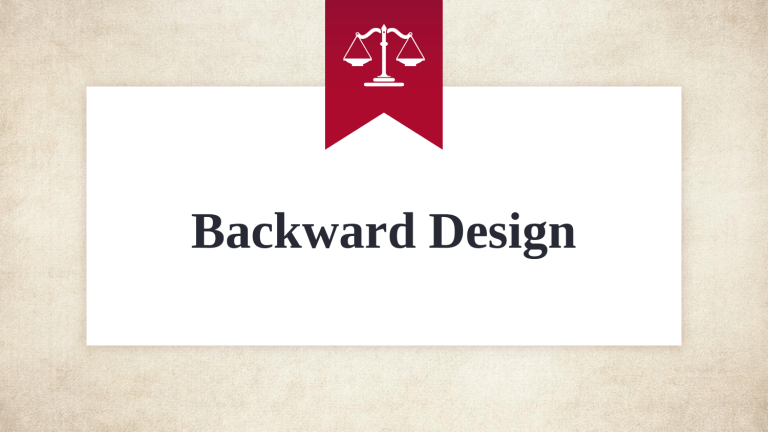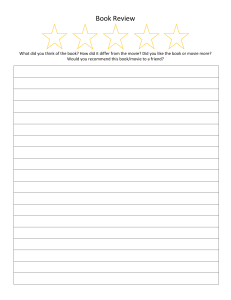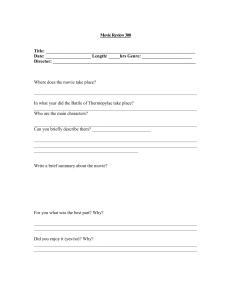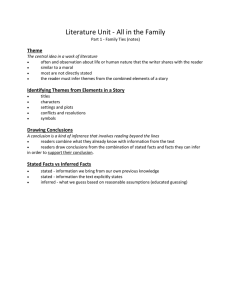
Backward Design “ To begin with the end in mind means to start with a clear understanding of your destination. It means to know where you’re going so that you better understand where you are now so that the steps you take are always in the right direction.” - Steven Covey (The 7 Habits of Highly Effective People 1989). 2 What is Backward Design? 3 ◈ “flipping” our instructional approach ◈ beginning with the end in mind ◈ setting goals and determining how to get there ⬩ Like pursuing a career! It’s like pursuing a career… 4 Three Stages / Steps of Backward Design 5 Identifying Desired Results Determining Evidence / Building Assessments Planning aligned lessons / activities / instruction Let’s Use an ELA example… 6 TEKS ELA.7.7(A): infer multiple themes within and across texts using text evidence. TEKS ELA.7.11(B): compose (. . .) argumentative texts using genre characteristics and craft Desired Outcomes 7 “Student will be able to infer multiple themes within and across texts using text evidence.” “Students will be able to compose an argumentative text using genre characteristics and craft.” Notes on Assessments 8 ◈ Before even considering lessons/activities ◈ assessments should reflect real-world experiences ◈ teaching the text or teaching the skill? ◈ alignment to “verbs” in the TEKS Big Question: What will they do so we will we know that they know what we want them to know? 9 Building Assessments You work for a marketing company that primarily promotes movies and television shows. “Student will be able to infer multiple themes within and across texts using text evidence.” “Book X” (ideally a book, story, or choice of texts that the students will read prior to this assignment), has been developed into a movie, and you have been tasked with convincing audiences everywhere to purchase tickets to this new movie. “Students will be able to compose an argumentative text using genre characteristics and craft.” Create a movie trailer/poster/Op-Ed in which you market this movie to the general public. In your advertisement, captivate the audience by telling them what lessons / larger concepts this movie explores without giving away the ending. Write a brief reflection in which you explore the themes you inferred and how you came to those conclusions. Three Stages / Steps of Backward Design 10 Identifying Desired Results Determining Evidence / Building Assessments Planning aligned lessons / activities / instruction Notes on Lessons/Activities 11 ◈ Keep the end in mind. ◈ Is the activity / skill / lesson aligned to rigor of the goal? ◈ What skills, mechanical or conceptual, will students need to perform effectively? ◈ What skills, mechanical or conceptual, do they already have? ◈ What experiences (repeated) will they need to build capacity / ability? ◈ What materials are most appropriate to accomplish the desired results? Lessons / Activities 12 You work for a marketing company that primarily promotes movies and television shows. “Book A” (ideally a book, story, or choice of texts that the students will read prior to this assignment), has been developed into a movie, and you have been tasked with convincing audiences everywhere to purchase tickets to this new movie. Create a movie trailer/poster/Op-Ed in which you market this movie to the general public. In your advertisement, captivate the audience by telling them what lessons / larger concepts this movie explores without giving away the ending. Write a brief reflection in which you explore the themes you inferred and how you came to those conclusions. What will they need to be able to do? ◈ ◈ ◈ ◈ ◈ ◈ become familiar with vocabulary use text evidence infer themes in texts ⬩ Know how to identify possible themes through characters, conflict, resolution, tone, etc. create an argument ⬩ (claim, reasoning, persuasive / rhetorical devices [loaded language, figurative language, hyperbole, appeals]) Summarize plot maintaining a logical order utilize technology to create a product (iMovie, PowerPoint, Google Slides, etc.) Example Lesson / Activity 13 Inferring Themes in a text: After introducing the concept of “theme” to the class, provide a choice board of Disney / Pixar shorts in which students collaboratively determine the lesson / message of the “text.” They must work to explain which elements of the short led them to the theme they’ve inferred. ◈ ◈ character charts (how did the character change over time?) conflict / resolution graphic organizer Have students “mix” groups and explain their inferred theme in their short to others’, and have other members determine if they agree / disagree and why. Example Lesson / Activity 14 Utilizing technology to create a product: Conduct a survey of the class, asking students what apps, programs, etc. they are proficient in or would like to learn to use. Based on the results, have a few students or groups of students create a presentation demonstrating their knowledge to the class so that the class can choose to use that program for their assessment. Leverage the abilities and skills of your students! Lesson and activities Assessment 15 Outcomes



